|
This section contains 909 words (approx. 4 pages at 300 words per page) |

|
SOURCE: “Mirrorshades,” in New Statesman & Society, March 3, 1995, pp. 40-1.
In the following review, Saynor offers tempered praise for The Black Album, finding shortcomings in Kureishi's lack of vision.
According to Milan Kundera, “human life is bounded by two chasms: fanaticism on one side, absolute scepticism on the other”. For Hanif Kureishi, though, these giant goal-markers can be surprisingly close together. The protagonist of The Black Album, Kureishi’s second novel, is partly an insolent cynic, in common with most of the author’s young male heroes. But he’s also partly in thrall to hardline Islam—just at the moment when The Satanic Verses becomes, literally, a burning issue.
Like its predecessor, The Buddha of Suburbia, the novel is a comic and profane portrait of the artist as a young gun, set amid the clamour of semi-bankrupt, pseudo-progressive cultures on the streets of a clapped-out London. Shahid Hasan...
|
This section contains 909 words (approx. 4 pages at 300 words per page) |

|


